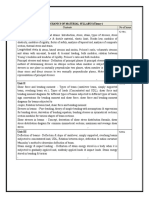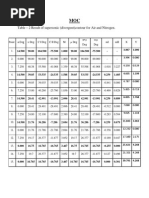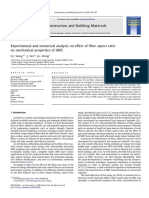0 ratings0% found this document useful (0 votes)
76 viewsMe217strength of Materials L T P C
Me217strength of Materials L T P C
Uploaded by
logicvirusThis document outlines a course on strength of materials that covers stress, strain, deformation, beams, torsion, deflection, and multiaxial stresses. The course objectives are to gain knowledge of stresses and deformations in components due to loads, assess stresses and deformations through mathematical models, and understand how dimensions and shape affect stresses and deformations. The course is divided into 5 units covering topics like stress and strain in solids, beams, torsion, deflection of beams and columns, and analysis of biaxial stresses. References for the course include several textbooks on mechanics of materials and strength of materials. The expected outcomes are to examine material properties, analyze shear and bending diagrams, explain applications of torsion,
Copyright:
© All Rights Reserved
Available Formats
Download as DOCX, PDF, TXT or read online from Scribd
Me217strength of Materials L T P C
Me217strength of Materials L T P C
Uploaded by
logicvirus0 ratings0% found this document useful (0 votes)
76 views2 pagesThis document outlines a course on strength of materials that covers stress, strain, deformation, beams, torsion, deflection, and multiaxial stresses. The course objectives are to gain knowledge of stresses and deformations in components due to loads, assess stresses and deformations through mathematical models, and understand how dimensions and shape affect stresses and deformations. The course is divided into 5 units covering topics like stress and strain in solids, beams, torsion, deflection of beams and columns, and analysis of biaxial stresses. References for the course include several textbooks on mechanics of materials and strength of materials. The expected outcomes are to examine material properties, analyze shear and bending diagrams, explain applications of torsion,
Original Description:
syllabus for snsct
Original Title
Me217strength of Materials l t p c
Copyright
© © All Rights Reserved
Available Formats
DOCX, PDF, TXT or read online from Scribd
Share this document
Did you find this document useful?
Is this content inappropriate?
This document outlines a course on strength of materials that covers stress, strain, deformation, beams, torsion, deflection, and multiaxial stresses. The course objectives are to gain knowledge of stresses and deformations in components due to loads, assess stresses and deformations through mathematical models, and understand how dimensions and shape affect stresses and deformations. The course is divided into 5 units covering topics like stress and strain in solids, beams, torsion, deflection of beams and columns, and analysis of biaxial stresses. References for the course include several textbooks on mechanics of materials and strength of materials. The expected outcomes are to examine material properties, analyze shear and bending diagrams, explain applications of torsion,
Copyright:
© All Rights Reserved
Available Formats
Download as DOCX, PDF, TXT or read online from Scribd
Download as docx, pdf, or txt
0 ratings0% found this document useful (0 votes)
76 views2 pagesMe217strength of Materials L T P C
Me217strength of Materials L T P C
Uploaded by
logicvirusThis document outlines a course on strength of materials that covers stress, strain, deformation, beams, torsion, deflection, and multiaxial stresses. The course objectives are to gain knowledge of stresses and deformations in components due to loads, assess stresses and deformations through mathematical models, and understand how dimensions and shape affect stresses and deformations. The course is divided into 5 units covering topics like stress and strain in solids, beams, torsion, deflection of beams and columns, and analysis of biaxial stresses. References for the course include several textbooks on mechanics of materials and strength of materials. The expected outcomes are to examine material properties, analyze shear and bending diagrams, explain applications of torsion,
Copyright:
© All Rights Reserved
Available Formats
Download as DOCX, PDF, TXT or read online from Scribd
Download as docx, pdf, or txt
You are on page 1of 2
ME217 STRENGTH OF MATERIALS L T P C
(Common to Aero, Automobile, Mechanical& Mechatronics) 3 1 0 4
OBJECTIVES
To gain knowledge of simple stresses, strains and deformation in components
due to external loads.
To assess stresses and deformations through mathematical models of beams,
twisting bars or combinations of both.
Effect of component dimensions and shape on stresses and deformations are to
be understood.
The study would provide knowledge for use in the design courses.
UNIT I STRESS STRAIN DEFORMATION OF SOLIDS 12
Rigid and Deformable bodies Strength, Stiffness and Stability - Stresses; Tensile,
Compressive and Shear - Deformation of simple and compound bars under axial load -
Elastic constants - Strain energy and unit strain energy - Strain energy in uniaxial loads.
UNIT II BEAMS SHEAR FORCE, BENDING MOMENT AND THEORY OF BENDING 10
Types of beams: Supports and Loads - Shear force and Bending Moment in beams -
Cantilever, Simply supported and Overhanging beams - Stresses in beams - Theory of
simple bending - Stress variation along the length and in the beam section. Strain energy in
bending.
UNIT III TORSION AND SPRINGS 12
Analysis of torsion of circular bars - Shear stress distribution - Bars of Solid and hollow
circular section - Stepped shaft - Twist and torsion stiffness - Compound shafts - Fixed and
simply supported shafts - Application to close-coiled helical springs - Maximum shear
stress in spring section including Wahl Factor - Deflection of helical coil springs under axial
loads - Design of helical coil springs - stresses in helical coil springs under torsion loads.
Strain energy in Torsion.
UNIT IV DEFLECTION OF BEAMS AND BUCKLING OF COLUMNS 14
Elastic curve of Neutral axis of the beam under normal loads - Evaluation of beam
deflection and slope: Double integration method, Macaulay Method, Moment-area Method -
Conjugate Beam Method - Columns - End conditions - Equivalent length of a column - Euler
equation - Slenderness ratio - Rankine formula for columns.
UNIT V ANALYSIS OF STRESSES IN TWO DIMENSIONS 12
Biaxial state of stresses - Thin cylindrical and spherical shells - Deformation in thin
cylindrical and spherical shells Biaxial stresses at a point - Stresses on inclined plane
Principal planes and stresses - Mohrs circle for biaxial stresses - Maximum shear stress.
TOTAL: 60 PERIODS
TEXT BOOKS
1. Popov E.P, Engineering Mechanics of Solids, Prentice-Hall of India, New Delhi,1997.
(Unit: I,II,III,IV&V)
2. Beer F. P. and Johnston R, Mechanics of Materials, McGraw-Hill Book Co, Third Edition,
2002. (Unit: I,II,III,IV&V)
REFERENCES
1. Nash W.A, Theory and problems in Strength of Materials, Schaum Outline Series,
McGraw-Hill Book Co, New York, 1995 (Unit: I,II,III,IV&V)
2. R.K.Rajput, Strength of Materials, S.Chand and Company Ltd.. (Unit: I,II,III,IV&V)
3. Ryder G.H, Strength of Materials, Macmillan India Ltd., Third Edition, 2002 (Unit:
I,II&III)
4. Ray Hulse, Keith Sherwin & Jack Cain, Solid Mechanics, Palgrave ANE Books,2004 (Unit:
I,II,III,IV&V).
5. Singh D.K Mechanics of Solids Pearson Education 2002. (Unit: I,II,III&IV)
6. Timoshenko S.P, Elements of Strength of Materials, Tata McGraw-Hill, New Delhi,1997.
(Unit: I,II,III,IV&V)
7. R.S.Khurmi, Strength of Materials, S.Chand and Company Ltd. (Unit: I,II,III,IV&V)
WEB RESOURCES
www.nptel.com
www.technologystudent.com
COURSE OUTCOMES
At the end of the course the student will
Examine and apply the various material properties for different applications.
Resolve the Shear Force and Bending moment diagram of all types.
Explain the application of torsion in circular, Stepped and Compound shafts.
Categories the beam deflection and to analyze the stresses.
You might also like
- ADC WellSharp Supervisor Homework Exercises Final Revised 08 Oct 2015 PDFDocument118 pagesADC WellSharp Supervisor Homework Exercises Final Revised 08 Oct 2015 PDFصالح100% (4)
- Engineering Drawing Multiple Choice QuestionDocument7 pagesEngineering Drawing Multiple Choice Questionlogicvirus62% (29)
- Mechanics of MaterialsDocument3 pagesMechanics of Materialssuhas_SCEM100% (1)
- St7018 Stability of StructuresDocument1 pageSt7018 Stability of StructuresKarthik NatesanNo ratings yet
- Wind Turbine DesignDocument58 pagesWind Turbine Designlogicvirus100% (1)
- Ce6306 Strength of Materials L T P CDocument1 pageCe6306 Strength of Materials L T P CmunijackNo ratings yet
- Smex1045 Strength of Materials 2 1 0 3 (1) - 1Document1 pageSmex1045 Strength of Materials 2 1 0 3 (1) - 1sankarsuper83No ratings yet
- Som & DmeDocument2 pagesSom & DmeSurulivelrajantNo ratings yet
- Simple Stresses and Strains Stress Strain Diagram - Ultimate Stress - Yield StressDocument1 pageSimple Stresses and Strains Stress Strain Diagram - Ultimate Stress - Yield StressramamurthiNo ratings yet
- Solid Mechanics SyllabusDocument2 pagesSolid Mechanics Syllabuserrohitverma25No ratings yet
- SM SyllabusDocument1 pageSM SyllabusAnantha NarayananNo ratings yet
- Syllabus Solid MechanicsDocument2 pagesSyllabus Solid MechanicsrajuNo ratings yet
- Som Syllabus (Ce2252)Document1 pageSom Syllabus (Ce2252)rajapratyNo ratings yet
- UNIT - II: Shear Force and Bending MomentDocument3 pagesUNIT - II: Shear Force and Bending MomentGopinath GangadhariNo ratings yet
- ME 201 Mechanics of SolidsDocument3 pagesME 201 Mechanics of SolidsSudeesh SudevanNo ratings yet
- Strength of Materials-I PDFDocument3 pagesStrength of Materials-I PDFMayur ChileNo ratings yet
- Mechanics of SolidsDocument1 pageMechanics of SolidsMouna GuruNo ratings yet
- Me201: Mechanics of Solids: End Semester ExamDocument1 pageMe201: Mechanics of Solids: End Semester ExamMuzammil MuhammedNo ratings yet
- Text BooksDocument1 pageText BooksPraveen KumarNo ratings yet
- Course Code Category Hours / Week Credits Maximum Marks L T P C CIA SEE TotalDocument2 pagesCourse Code Category Hours / Week Credits Maximum Marks L T P C CIA SEE TotalideepujNo ratings yet
- Mechanics of Solid: PME3I101Document3 pagesMechanics of Solid: PME3I101Anonymous kTVBUxrNo ratings yet
- B.E. Civil Engineering - Fulltime: Text BooksDocument1 pageB.E. Civil Engineering - Fulltime: Text BooksPrakash MahandraNo ratings yet
- Jawaharlal Nehru Technological University Hyderabad L T/P/D C II Year B.Tech. M.E. - I Sem (53016) MECHANICS OF SOLIDS 3 1/-/-3 UNIT-1Document1 pageJawaharlal Nehru Technological University Hyderabad L T/P/D C II Year B.Tech. M.E. - I Sem (53016) MECHANICS OF SOLIDS 3 1/-/-3 UNIT-1simalaraviNo ratings yet
- Mechanics of Material - SyllabusDocument2 pagesMechanics of Material - SyllabusRahul PatilNo ratings yet
- FLUID MECHANICS-11-12Document2 pagesFLUID MECHANICS-11-12Muthulakshmi MaruthanayagamNo ratings yet
- 12ce401 Strength of Materials 3 1 0 4Document2 pages12ce401 Strength of Materials 3 1 0 4Sathishkumar PalanippanNo ratings yet
- Strength of MaterialsDocument1 pageStrength of Materialsdhana555No ratings yet
- Som EnglishDocument343 pagesSom Englishbala vigneshNo ratings yet
- ME 201 Mechanics of SolidsDocument2 pagesME 201 Mechanics of SolidsUnnikrishnan TGNo ratings yet
- Strength of Material QuantumDocument349 pagesStrength of Material QuantumAkash Singh100% (4)
- 7Document2 pages7jokersemxyNo ratings yet
- Strength of Materials (9024)Document6 pagesStrength of Materials (9024)rajyamgarNo ratings yet
- Advanced Mechanics of Solids: Course Code: 15ME1114 L T P C 3 0 0 3Document3 pagesAdvanced Mechanics of Solids: Course Code: 15ME1114 L T P C 3 0 0 3dsfsfNo ratings yet
- Strength of Materials - IDocument2 pagesStrength of Materials - IJosephNo ratings yet
- Advanced Solid Mechanics 15BME-OSM22T (3-1-0) Unit IDocument1 pageAdvanced Solid Mechanics 15BME-OSM22T (3-1-0) Unit IHitesh GahlawatNo ratings yet
- SOM CivilDocument7 pagesSOM CivilVikram RaoNo ratings yet
- MosDocument2 pagesMosSrikant PotluriNo ratings yet
- Mechanics of SolidsDocument3 pagesMechanics of SolidsVishal SinghNo ratings yet
- Pre Requisite: BE 100 Engineering MechanicsDocument3 pagesPre Requisite: BE 100 Engineering MechanicsBalagopal VNo ratings yet
- 4.80 S.E Mechanical EngineeringDocument2 pages4.80 S.E Mechanical Engineeringq8400No ratings yet
- Unit I: Text BooksDocument2 pagesUnit I: Text Booksmahalakshmi3104976No ratings yet
- CE Strength of Materials I L T PC 3 0 0 3 ObjectivesDocument4 pagesCE Strength of Materials I L T PC 3 0 0 3 ObjectivesAnonymous H7nsyCogNo ratings yet
- MOS SyllabusDocument2 pagesMOS SyllabusAnil kumarNo ratings yet
- Advanced Som SyllabusDocument1 pageAdvanced Som SyllabusRaj Kumar0% (1)
- Syllabus MosDocument3 pagesSyllabus Mosanumuth18No ratings yet
- Mechanics of Solids Unit - I: Chadalawada Ramanamma Engineering CollegeDocument1 pageMechanics of Solids Unit - I: Chadalawada Ramanamma Engineering CollegeMITTA NARESH BABUNo ratings yet
- WWW - Ktustudents.In: 1. Rattan, Strength of Materials, 2E Mcgraw Hill Education India, 2011Document3 pagesWWW - Ktustudents.In: 1. Rattan, Strength of Materials, 2E Mcgraw Hill Education India, 2011SherwinNo ratings yet
- Strength of Materials - IIDocument2 pagesStrength of Materials - IIATANU PAULNo ratings yet
- Mechanics of Materials: Class-Ii-Ii Sem Branch-MechanicalDocument13 pagesMechanics of Materials: Class-Ii-Ii Sem Branch-MechanicalRamu AmaraNo ratings yet
- MOS-1, SlyDocument2 pagesMOS-1, SlyManish KumarNo ratings yet
- 3Document5 pages3BALRAJNo ratings yet
- 2 3-SomDocument67 pages2 3-SomGowtham SmartyNo ratings yet
- Mechanics of Solids: Mr. Y. B. Kumbhar Ybk - Aero@adcet - inDocument19 pagesMechanics of Solids: Mr. Y. B. Kumbhar Ybk - Aero@adcet - inYogesh KumbharNo ratings yet
- Unit I-1Document44 pagesUnit I-1sanjaymagnetoooNo ratings yet
- Objective:: Unit Topic No. Topic Period Books ReferredDocument4 pagesObjective:: Unit Topic No. Topic Period Books Referredkarthiksubramanian94No ratings yet
- Avs 1Document2 pagesAvs 1vishnu351No ratings yet
- Ce Structural Mechanics NDocument271 pagesCe Structural Mechanics Nat vimalaNo ratings yet
- Structural Mechanics-Ii Section I: Unit 1Document1 pageStructural Mechanics-Ii Section I: Unit 1Naval YemulNo ratings yet
- Syllabus Strength of MaterialDocument5 pagesSyllabus Strength of MaterialIDTR JamshedpurNo ratings yet
- Hyperbolic Structures: Shukhov's Lattice Towers - Forerunners of Modern Lightweight ConstructionFrom EverandHyperbolic Structures: Shukhov's Lattice Towers - Forerunners of Modern Lightweight ConstructionNo ratings yet
- 1800 Mechanical Movements, Devices and AppliancesFrom Everand1800 Mechanical Movements, Devices and AppliancesRating: 4 out of 5 stars4/5 (7)
- TN Police CUG PV299Document2 pagesTN Police CUG PV299logicvirusNo ratings yet
- Tiruvallur District - Tiruvallur Taluk - Revenue VillagesDocument7 pagesTiruvallur District - Tiruvallur Taluk - Revenue VillageslogicvirusNo ratings yet
- Unicorn Insurance2016Document1 pageUnicorn Insurance2016logicvirusNo ratings yet
- Iqac Monthly ReportDocument2 pagesIqac Monthly ReportlogicvirusNo ratings yet
- Monitoring Report TutorialDocument1 pageMonitoring Report TutoriallogicvirusNo ratings yet
- Assignment 2Document2 pagesAssignment 2logicvirus0% (1)
- Moc of Air and NitrogenDocument4 pagesMoc of Air and NitrogenlogicvirusNo ratings yet
- Chpt05-FEM For 2D SolidsnewDocument56 pagesChpt05-FEM For 2D SolidsnewKrishna MyakalaNo ratings yet
- Unit I - Introduction of Fatigue FailureDocument32 pagesUnit I - Introduction of Fatigue Failurelogicvirus100% (1)
- Introduction To Computer Science (I) : T. K. Yin, Nuk-CsieDocument57 pagesIntroduction To Computer Science (I) : T. K. Yin, Nuk-CsielogicvirusNo ratings yet
- Timoshenko, S. P., 1921, On The Correction Factor For Shear of The Differential Equation For Transverse Vibrations of Bars of Uniform Cross-SectioDocument1 pageTimoshenko, S. P., 1921, On The Correction Factor For Shear of The Differential Equation For Transverse Vibrations of Bars of Uniform Cross-SectiologicvirusNo ratings yet
- d7dd76b5-952b-44a2-aedd-abb43ca0e38bDocument38 pagesd7dd76b5-952b-44a2-aedd-abb43ca0e38bMANUEL ALEJANDRO LOZANO BELLIDONo ratings yet
- Experimental Methods For Lode Angle Characterization in Ductile FractureDocument21 pagesExperimental Methods For Lode Angle Characterization in Ductile FractureTruong Phuoc TriNo ratings yet
- Hindustan Construction Co. Ltd. Mumbai. Subject: Details: Table 19 ofDocument14 pagesHindustan Construction Co. Ltd. Mumbai. Subject: Details: Table 19 ofHemant Sonawadekar100% (1)
- Vol6i Ology: The Dimensions and Dynamics of Volcanic Eruption ColumnsDocument2 pagesVol6i Ology: The Dimensions and Dynamics of Volcanic Eruption ColumnsSudirman SamadNo ratings yet
- Effect of Aspect Ratio and Volume Fraction of Steel Fiber On The Mechanical Properties of SFRCDocument7 pagesEffect of Aspect Ratio and Volume Fraction of Steel Fiber On The Mechanical Properties of SFRCvidal3213No ratings yet
- Science Matter (5-6)Document19 pagesScience Matter (5-6)Corinne Mae DacunesNo ratings yet
- CondutosDocument6 pagesCondutosLuiz Gabriel Alves de DeusNo ratings yet
- HeatDocument34 pagesHeatReese ChoconutNo ratings yet
- Assignment 1 Dimensional AnalasisDocument1 pageAssignment 1 Dimensional AnalasisVivek ThakkarNo ratings yet
- Effect of Moisture and Temperature On Composite MaterialsDocument22 pagesEffect of Moisture and Temperature On Composite MaterialsAhmad HamadehNo ratings yet
- ME6604-Gas Dynamics and Jet Propulsion PDFDocument12 pagesME6604-Gas Dynamics and Jet Propulsion PDFNANCY JUDITHNo ratings yet
- Biomedical Physics Lecture 1Document12 pagesBiomedical Physics Lecture 1Derrick VangennepNo ratings yet
- Fracture Intro 9 Pics NoLogoDocument20 pagesFracture Intro 9 Pics NoLogoRaj RamanathanNo ratings yet
- Lauterbach Verfahrenstechnik GMBH - Software For Thermal and Hydraulic Design of Heat ExchangersDocument28 pagesLauterbach Verfahrenstechnik GMBH - Software For Thermal and Hydraulic Design of Heat Exchangerssukanta60No ratings yet
- Cell Splitting NiranjanDocument25 pagesCell Splitting NiranjanSachin ZanjeNo ratings yet
- Shear Strength and Deterioration of Short Reinforced Concrete Columns Under Cyclic DeformationsDocument277 pagesShear Strength and Deterioration of Short Reinforced Concrete Columns Under Cyclic DeformationsmcajahuancaNo ratings yet
- Pascals Law ProofDocument3 pagesPascals Law ProofLinda Fahlberg-Stojanovska60% (5)
- Abaqus User Guide - Damage Initiation For Fiber-Reinforced CompositesDocument4 pagesAbaqus User Guide - Damage Initiation For Fiber-Reinforced CompositespeymanNo ratings yet
- Chapter 2, Oct 8Document24 pagesChapter 2, Oct 8Sabin Leroy HmgnNo ratings yet
- Me 630: Advanced Heat Transfer CH 8. Radiation Heat Transfer Assoc. Prof. Dr. Barbaros ÇetinDocument38 pagesMe 630: Advanced Heat Transfer CH 8. Radiation Heat Transfer Assoc. Prof. Dr. Barbaros ÇetinAaaereNo ratings yet
- CheckChecklist For Energy Efficiency in BuildingsDocument6 pagesCheckChecklist For Energy Efficiency in BuildingsDusan GordicNo ratings yet
- ASE 342 - Aerodynamics II: ExampleDocument10 pagesASE 342 - Aerodynamics II: ExampleMert YılmazNo ratings yet
- EHL PrincipleDocument2 pagesEHL PrincipleAnonymous alQXB11EgQNo ratings yet
- Lee Kesler Simple Fluid Zfactor 1 PublDocument4 pagesLee Kesler Simple Fluid Zfactor 1 PublPrinshu RawatNo ratings yet
- Vapor-Liquid EquilibriaDocument47 pagesVapor-Liquid EquilibriaKent GardoseNo ratings yet
- Reservoir Engineering-Oil RecoveryDocument24 pagesReservoir Engineering-Oil Recoveryt01lx23No ratings yet
- Thermodynamics Properties of FluidsDocument70 pagesThermodynamics Properties of FluidsCesar BravoNo ratings yet
- Materials and Design: Farshid Rikhtegar, Mostafa KetabchiDocument6 pagesMaterials and Design: Farshid Rikhtegar, Mostafa Ketabchiפּואַ פּוגאַNo ratings yet





































































































